Motion Law and Mechanical Properties of PIGs When Passing through a Pipe Bend
Abstract
:1. Introduction
2. Materials and Methods
2.1. Equation of Motion
2.2. Experimental System
2.3. Effect of the Number of Leather Cups on PIG Cornering
3. Results
3.1. Effect of Changing the Number of Leather Cups on PIG Cornering
3.2. The Effect of the Cup Spacing Ratio on PIG Cornering
3.3. Analysis of the Cornering Characteristics of Double-Cabin PIGs
3.4. Mechanical Properties of the Cup and the Core Tube
4. Conclusions
- (1)
- Through simulation research, the PIG speed of the two leather cups is the fastest in cornering, but the stress on the leather cups is too large, which can easily cause damage to the PIG leather cups. The speed of the leather cup PIG is very low when cornering, which affects its overall ability to pass through the pipe. When choosing the number of leather cups for the PIG to bend, one can give priority to four leather PIGs or six leather PIGs, which can improve the situation in which the PIGs block the pipeline due to wear of the leather cups.
- (2)
- When the leather cup interval ratio is 3%, the running speed is the fastest, but the PIG leather cup is easily damaged when the maximum stress reaches 9 MPa. The ratio of the leather cup interval to 10% of the PIG easily causes jamming when cornering, and the speed sharply decreases. Since the ratio of the leather cup interval to the length of the PIG is 7%, this setup is better than those of the other scenarios.
- (3)
- The increase in the number of cabins will seriously reduce the speed of the PIG movement, and the transmission of the force of the universal joint to the second half of the curve during cornering will also affect the entire PIG cornering speed. The force between the cross-universal joints is basically uniform during the whole movement process, and at some point, the force between the driving fork and the driven fork suddenly increases, which will cause the stress on the cup to increase. Additionally, the cup and pipe disengagement affect the movement of the entire PIG. When using the dual-cabin PIG for cornering, the damage to the leather cup can be decreased to a certain extent, the pressure difference between the front and rear is stable, and the service life of the leather cup is increased. However, the more important task is to solve the PIG power problem.
- (4)
- The contact force between each cup and the core tube remains basically unchanged during the bend, but when the pipeline robot collides with the pipeline, the contact force generated is much greater than the contact force before the collision. At the same time, the second cup closest to the core tube has the largest contact force with the core tube during movement. Therefore, during processing, strengthening the stability of the connection between the leather cup near the core tube and the core tube and thickening the leather cup to prevent damage to the leather cup caused by excessive contact force are considered.
Author Contributions
Funding
Acknowledgments
Conflicts of Interest
References
- Sakakibara, N.; Kyriakides, S.; Corona, E. Collapse of partially corroded or worn pipe under external pressure. Int. J. Mech. Sci. 2008, 50, 1586–1597. [Google Scholar] [CrossRef]
- Zhang, C.; Rathnayaka, S.; Shannon, B.; Ji, J.; Kodikara, J. Numerical interpretation of pressurized corroded cast iron pipe tests. Int. J. Mech. Sci. 2017, 128–129, 116–124. [Google Scholar] [CrossRef] [Green Version]
- Liu, Y.; Cen, Z.; Chen, H.; Xu, B. Plastic collapse analysis of defective pipelines under multi-loading systems. Int. J. Mech. Sci. 2000, 42, 1607–1622. [Google Scholar] [CrossRef]
- Lu, H.; Iseley, T.; Behbahani, S.; Fu, L. Leakage detection techniques for oil and gas pipelines: State-of-the-art. Tunn. Undergr. Space Technol. 2020, 98, 103249. [Google Scholar] [CrossRef]
- Sina, R.; Raheleh, J.; Alexander, G. A review on different pipeline defect detection techniques. Flow Model. Control. Pipeline Syst. 2021, 321, 25–57. [Google Scholar]
- Ye, H.; Qian, J.; Yan, S.; Jiang, C.; Wei, L.; Jin, Z.-J. Limit bending moment for pipes with two circumferential flaws under combined internal pressure and bending. Int. J. Mech. Sci. 2016, 106, 319–330. [Google Scholar] [CrossRef]
- Azpiroz, J.E.; Hendrix, M.H.W.; Breugem, W.-P.; Henkes, R.A.W.M. CFD Modelling of Bypass Pigs with a Deflector Disk. In Proceedings of the 17th International Conference on Multiphase Production Technology, Cannes, France, 10–12 June 2015; pp. 141–158. [Google Scholar]
- Kohda, K.; Suzukawa, Y.; Furukawa, H. New method for analyzing transient flow after pigging scores well. Oil Gas J. 1988, 86, 40–47. [Google Scholar]
- Kohda, K.; Suzukawa, Y.; Furukawa, H. Pigging analysis for gas-liquid two phase flow in pipelines. In Proceedings of the ASME Annual Energy Resources Technology Conference and Exhibition, New Orleans, LA, USA; 1988; pp. 33–38. [Google Scholar]
- Wang, L.; Bi, H.; Yang, Y.; Zhang, Y.; Li, Y. Response analysis of an aerial-crossing gas-transmission pipeline during pigging operations. Int. J. Press. Vessel. Pip. 2018, 165, 286–294. [Google Scholar] [CrossRef]
- Wang, L.; Yang, Y.; Liu, C.; Li, Y.; Hu, Q. Numerical investigation of dynamic response of a pipeline-riser system caused by severe slugging flow. Int. J. Press. Vessel. Pip. 2018, 159, 15–27. [Google Scholar] [CrossRef]
- Wang, L.; Yang, Y.; Li, Y.; Wang, Y. Dynamic behaviours of horizontal gas-liquid pipes subjected to hydrodynamic slug flow: Modelling and experiments. Int. J. Press. Vessel. Pip. 2018, 161, 50–57. [Google Scholar] [CrossRef]
- Xinyu, Z.; Bo, Z.; Yuanzhang, J.; Bo, L.; Rui, L.; Lin, Z.; Qiao, S.; Xiaoli, Z. Analysis of Rotation of Pigs during Pigging in Gas Pipeline. In Proceedings of the 2015 International Conference on Fluid Power and Mechatronics (FPM), Harbin, China, 5–7 August 2015; pp. 892–895. [Google Scholar]
- Aksenov, D.V.; Shcherbakov, V.I.; Leshchenko, V.V. Selection of structural parameters of an inspection pig for arterial oil and gas pipelines from conditions of dynamics. Chem. Pet. Eng. 2013, 49, 265–269. [Google Scholar] [CrossRef]
- Shcherbakov, V.I.; Aksenov, D.V. Selecting the mechanical parameters of an inspection device for oil and gas lines. Russ. Eng. Res. 2013, 33, 679–682. [Google Scholar] [CrossRef]
- Aksenov, D.V.; Shcherbakov, V.I.; Leshchenko, V.V. Self-oscillation of flaw-detection equipment for arterial gas pipelines. Chem. Pet. Eng. 2012, 48, 364–371. [Google Scholar] [CrossRef]
- Saeidbakhsh, M.; Rafeeyan, M.; Ziaei-Rad, S. Dynamic Analysis of Small Pigs in Space Pipelines. Oil Gas Sci. Technol. 2008, 64, 155–164. [Google Scholar] [CrossRef]
- Lesani, M.; Rafeeyan, M.; Sohankar, A. Dynamic analysis of small pig through two and three-dimensional liquid pipeline. J. Appl. Fluid Mech. (JAFM) 2012, 5, 75–83. [Google Scholar]
- Quarini, J.; Shire, S. A review of fluid-driven pipeline pigs and their applications. Proc. Inst. Mech. Eng. Part E 2007, 221, 1–10. [Google Scholar] [CrossRef]
- Dongyuan, S.; Yang, X.; Wasim, H.; Hongxi, R.; Xiaoyan, T. Fluid-Solid Coupling Numerical Analysis of Dynamic Vibration Characteristics of the Pipeline Inspection Gauge (PIG) in the Pipeline. In Proceedings of the INTER-NOISE and NOISE-CON Congress and Conference Proceedings, Hong Kong, China, 27–30 August 2017; pp. 261–269. [Google Scholar]
- Hongxi, R.; Dongyuan, S.; Yang, X.; Hongchao, W. Research on Dynamics and Vibration Response in Pipeline Inspection Gauge (PIG) Based on the CEL Method. In Proceedings of the INTER-NOISE and NOISE-CON Congress and Conference Proceedings, Hong Kong, China; 2017; pp. 56–67. [Google Scholar]
- Cao, Y.; Liu, C.; Tian, H.; Sun, Y.; Zhang, S. Mechanical behaviors of pipeline inspection gauge (pig) in launching process based on Coupled Eulerian-Lagrangian (CEL) method. Int. J. Press. Vessel. Pip. 2022, 197, 104622. [Google Scholar] [CrossRef]
- Cao, Y.; Chang, Q.; Zhen, Y. Numerical simulation of fracture behavior for the pipeline with girth weld under axial load. Eng. Fail. Anal. 2022, 136, 106221. [Google Scholar] [CrossRef]
- Azevedo, L.; Bracm, A.; Nieckele, A.; Naccxhe, M.; Gomes, M. Simple HydrodynamicModels for the Prediction of Pig Motions in Pipelines. In Proceedings of the Offshore Technology Conference, Houston, TX, USA, 6 May 1996; pp. 729–739. [Google Scholar] [CrossRef]
- Nieckele, A.O.; Braga, A.M.B.; Azevedo, L.F.A. Transient Pig Motion Through Gas and Liquid Pipelines. J. Energy Resour. Technol. 2001, 123, 260–269. [Google Scholar] [CrossRef]
- Azevedo, L.; Braga, A.; Nieckele, A.; Souza Mendes, P. Simulating pipeline pigging operations. In Proceedings of the Pipeline Pigging Conference, Stavanger, Norway, 15 June 1999; pp. 15–17. [Google Scholar]
- Solghar, A.A.; Davoudian, M. Analysis of Transient PIG Motion in Natural Gas Pipeline. Mech. Ind. 2012, 13, 293–300. [Google Scholar] [CrossRef]
- Esmaeilzadeh, F.; Mowla, D.; Asemani, M. Mathematical modeling and simulation of pigging operation in gas and liquid pipelines. J. Pet. Sci. Eng. 2009, 69, 100–106. [Google Scholar] [CrossRef]
- Esmaeilzadeh, F.; Asemani, M.; Mowla, D. Modeling of Pig Operations in Natural Gas and Liquid Pipeline. In Proceedings of the SPE Annual Technical Conference and Exhibition, San Antonio, TX, USA, 24 September 2006; pp. 1–4. [Google Scholar] [CrossRef]
- Ayala, L.F.; Eltohami, E.S.; Adewumi, M.A. A Unified Two-Fluid Model for Multiphase Flow in Natural Gas Pipelines. In Proceedings of the Engineering Technology Conference on Energy, Houston, TX, USA, 4–5 February 2002; pp. 839–845. [Google Scholar] [CrossRef]
- Ayala, L.F.; Adewumi, M.A. Low-Liquid Loading Multiphase Flow in Natural Gas Pipelines. J. Energy Resour. Technol. 2003, 125, 284–293. [Google Scholar] [CrossRef]
- Ayala, O.; Ayala, L.; Ayala, O. Multi-phase Flow Analysis in Oil and Gas Engineering Systems and its Modelling. Hydrocarb. World 2007, 2007, 57–60. [Google Scholar]
- Durali, M.; Fazeli, A.; Nabi, A. Investigation of Dynamics and Vibration of PIG in Oil and Gas Pipelines. In Proceedings of the ASME International Mechanical Engineering Congress and Exposition, Seattle, DC, USA, 11–15 November 2007; pp. 2015–2024. [Google Scholar] [CrossRef]
- Zhang, H.; Zhang, S.; Guo, S.; Mingjun, O.U.; Lin, L. Dynamics Simulation on Bi-directional PIG’Sealing Dish Passing through Girth Weld in Pipeline. Oil Field Equip. 2015, 44, 22–27. [Google Scholar] [CrossRef]
- Zhang, H.; Qing, L.I.; Liu, S.; Mingjun, O.U.; Lin, L. Effect on Stiffness Characteristics of Large Bi-directional PIG’s Rubber Sealing Disc by Its Thickness. Oil Field Equip. 2015, 44, 12–18. [Google Scholar]
- Xiang, J.; Morgenstern, H.; Li, Y.; Steffick, D.; Bragg-Gresham, J.; Panapasa, S.; Raphael, K.L.; Robinson, B.M.; Herman, W.H.; Saran, R. Incidence of ESKD Among Native Hawaiians and Pacific Islanders Living in the 50 US States and Pacific Island Territories. Am. J. Kidney Dis. 2020, 76, 340–349.e1. [Google Scholar] [CrossRef]
- Zhang, X.; Liu, S.; Qing, L.I.; Zhang, S. Effect of Interference of Leather Sealing Disc to Stiffness of PIG. Process Equip. Piping 2015, 52, 82–86. [Google Scholar]
- He, H.; Liang, Z.; Cui, X. Molding and Simulation of Pig Speed with Brake Unit in Gas Pipeline. J. Pipeline Syst. Eng. Pract. 2020, 11, 04019042. [Google Scholar] [CrossRef]
- Liang, Z.; He, H.; Cai, W. Speed simulation of bypass hole PIG with a brake unit in liquid pipe. J. Nat. Gas Sci. Eng. 2017, 42, 40–47. [Google Scholar] [CrossRef]
- Zhu, X.; Zhang, S.; Wang, D.; Wang, W.; Liu, S. The impact of pipeline bend on bi-directional pig and the theories for the optimal pig design. In Proceedings of the 2013 IEEE International Conference on Mechatronics and Automation, Takamatsu, Japan, 4–7 August 2013; pp. 87–92. [Google Scholar]
- Wang, W.; Song, S.; Zhang, S.; Yu, D. Impact analysis of pigging in shield segment of gas pipe. In Proceedings of the 2012 IEEE International Conference on Mechatronics and Automation, Chengdu, China, 5–8 August 2012; pp. 203–207. [Google Scholar] [CrossRef]
- Deng, T.; Zhou, J.; Liang, G.; Xiao, Y.; Zhu, B.; Gong, J. Numerical Simulation of Pigging Operation through Curved Pipeline Coupling a T-Abrupt and Bend Drain Pipe. J. Pipeline Syst. Eng. Pract. 2021, 12, 04020052. [Google Scholar] [CrossRef]
- Deng, T.; Zhou, J.; Zhou, X.; Meng, T.; Liang, G.; Gong, J. Transient simulation of vapor-liquid eruption and overpressure in the drainage terminal of an inclined pipeline during pigging process after water pressure test. Water Supply 2020, 21, 204–216. [Google Scholar] [CrossRef]
- Liu, C.; Wei, Y.; Cao, Y.; Zhang, S.; Sun, Y. Traveling ability of pipeline inspection gauge (PIG) in elbow under different friction coefficients by 3D FEM. J. Nat. Gas Sci. Eng. 2020, 75, 103134. [Google Scholar] [CrossRef]
- Liu, C.; Cao, Y.; Jinzhong, C.; Renyang, H.; Xin, J.; Wu, S. Research on Mechanical Behaviors of Submarine Pipeline Inspection Gauges in the Elbow: Fsi Simulation and Mathematic Modeling. 2022, pp. 1–28. Available online: https://papers.ssrn.com/sol3/papers.cfm?abstract_id=4186661 (accessed on 18 October 2022).
- Liu, C.; Yuguang, C.; Jinzhong, C.; Chaolei, D.; Renyang, H.; Zhenggan, Z. The Blockage Risk in the Elbow of the Bi-Directional Pig Used for Submarine Pipeline Based on the Modified Burgers-Frenkel (Mb-F) Model. 2022, pp. 1–29. Available online: https://papers.ssrn.com/sol3/papers.cfm?abstract_id=4170957 (accessed on 18 October 2022).
- Zhu, X.; Wang, D.; Yeung, H.; Zhang, S.; Liu, S. Comparison of linear and nonlinear simulations of bidirectional pig contact forces in gas pipelines. J. Nat. Gas Sci. Eng. 2015, 27, 151–157. [Google Scholar] [CrossRef]
- Zhu, X.; Zhang, S.; Li, X.; Wang, D.; Yu, D. Numerical simulation of contact force on bi-directional pig in gas pipeline: At the early stage of pigging. J. Nat. Gas Sci. Eng. 2015, 23, 127–138. [Google Scholar] [CrossRef]
- Zhu, X.; Wang, W.; Zhang, S.; Liu, S. Experimental Research on the Frictional Resistance of Fluid-Driven Pipeline Robot with Small Size in Gas Pipeline. Tribol. Lett. 2017, 65, 49. [Google Scholar] [CrossRef]
- Canavese, G.; Scaltrito, L.; Ferrero, S.; Pirri, C.; Cocuzza, M.; Pirola, M.; Corbellini, S.; Ghione, G.; Ramella, C.; Verga, F.; et al. A novel smart caliper foam pig for low-cost pipeline inspection—Part A: Design and laboratory characterization. J. Pet. Sci. Eng. 2015, 127, 311–317. [Google Scholar] [CrossRef]
- Ramella, C.; Canavese, G.; Corbellini, S.; Pirola, M.; Cocuzza, M.; Scaltrito, L.; Ferrero, S.; Pirri, C.; Ghione, G.; Rocca, V.; et al. A novel smart caliper foam pig for low-cost pipeline inspection–Part B: Field test and data processing. J. Pet. Sci. Eng. 2014, 133, 771–775. [Google Scholar] [CrossRef]
- Nguyen, T.T.; Kim, D.K.; Rho, Y.W.; Kim, S.B. Dynamic modeling and its analysis for PIG flow through curved section in natural gas pipeline. In Proceedings of the Proceedings 2001 IEEE International Symposium on Computational Intelligence in Robotics and Automation (Cat. No. 01EX515), Banff, AB, Canada, 29 July–1 August 2001; pp. 492–497. [Google Scholar] [CrossRef]
- Nguyen, T.T.; Yoo, H.R.; Rho, Y.W.; Kim, S.B. Speed control of PIG using bypass flow in natural gas pipeline. In Proceedings of the ISIE 2001. 2001 IEEE International Symposium on Industrial Electronics Proceedings (Cat. No. 01TH8570), Pusan, Korea, 12–16 June 2001; pp. 863–868. [Google Scholar] [CrossRef]
- Hendrix, M. Experiments and Modelling for By-Pass Pigging of Pipelines. Ph.D. Thesis, Delft University of Technology, Delft, The Netherlands, 2020; pp. 2–6. [Google Scholar] [CrossRef]
- Yang, L.; Fu, H.; Liang, H.; Wang, Y.; Han, G.; Ling, K. Detection of pipeline blockage using lab experiment and computational fluid dynamic simulation. J. Pet. Sci. Eng. 2019, 183, 106421. [Google Scholar] [CrossRef]
- Fu, H.; Yang, L.; Liang, H.; Wang, S.; Ling, K. Diagnosis of the single leakage in the fluid pipeline through experimental study and CFD simulation. J. Pet. Sci. Eng. 2020, 193, 107437. [Google Scholar] [CrossRef]
- Mishra, D.; Agrawal, K.K.; Abbas, A.; Srivastava, R.; Yadav, R.S. PIG [Pipe Inspection Gauge]: An Artificial Dustman for Cross Country Pipelines. Procedia Comput. Sci. 2019, 152, 333–340. [Google Scholar] [CrossRef]
- Feng, C.L.; Wang, D.S.; Zhu, Y.Y. Analysis of Moment Transmitted by Universal Joint in Varying Operating Condition. Adv. Eng. Forum 2011, 2–3, 999–1003. [Google Scholar] [CrossRef] [Green Version]
- Feng, C.L.; Zhu, Y.Y.; Wang, D.S. Super-Harmonic Resonance Analysis on Torsional Vibration of Misaligned Rotor Driven by Universal Joint. Appl. Mech. Mater. 2010, 26–28, 1226–1231. [Google Scholar] [CrossRef]
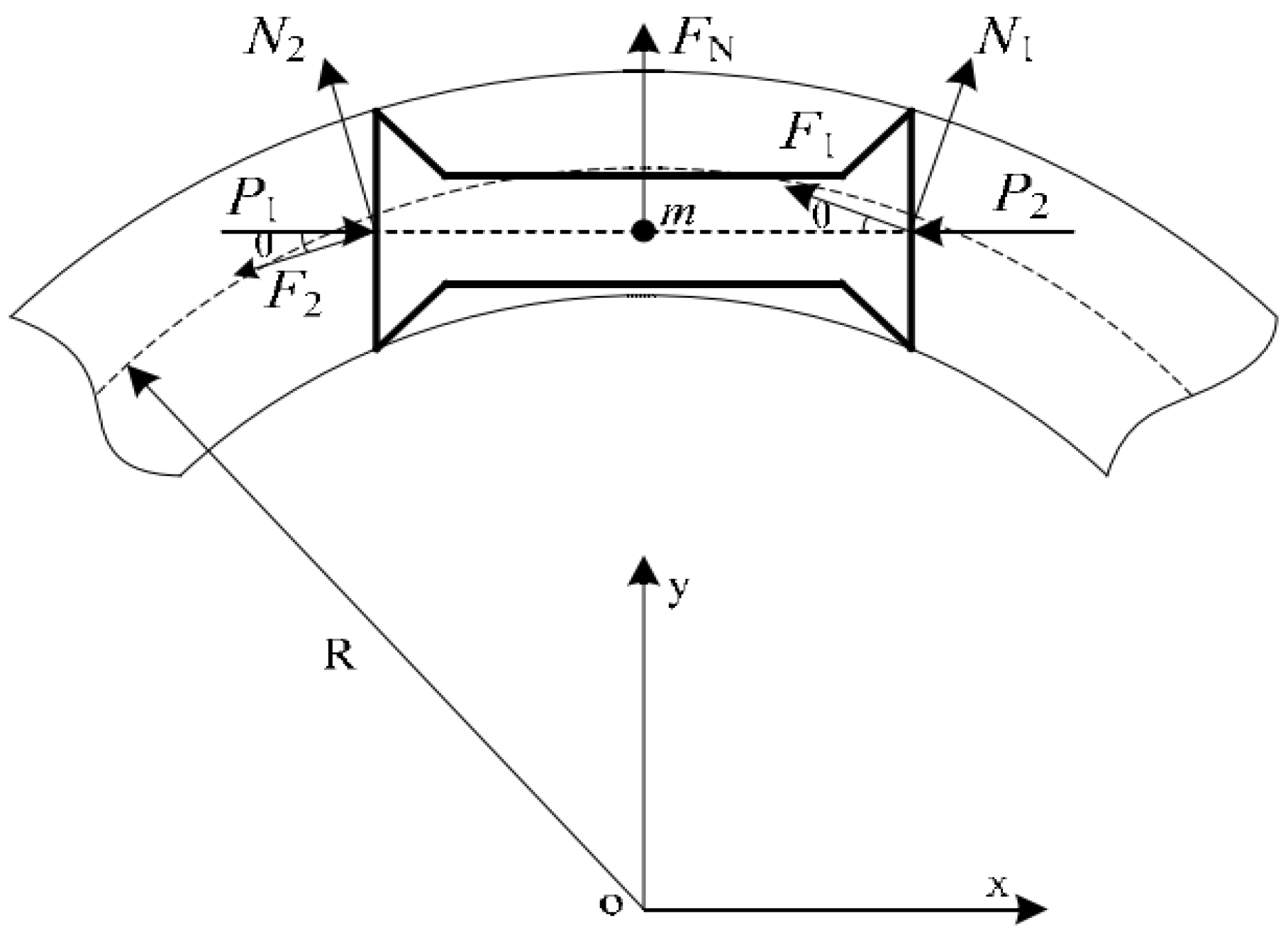
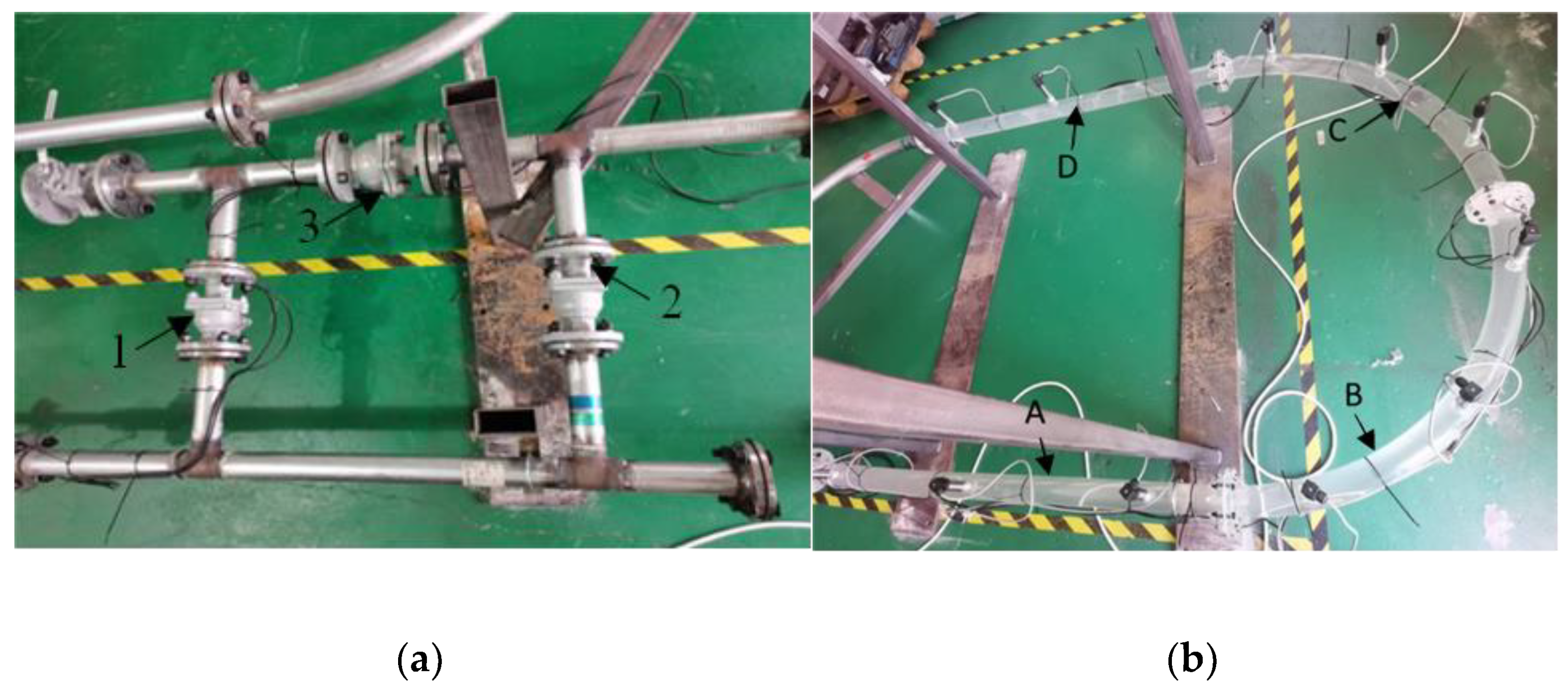


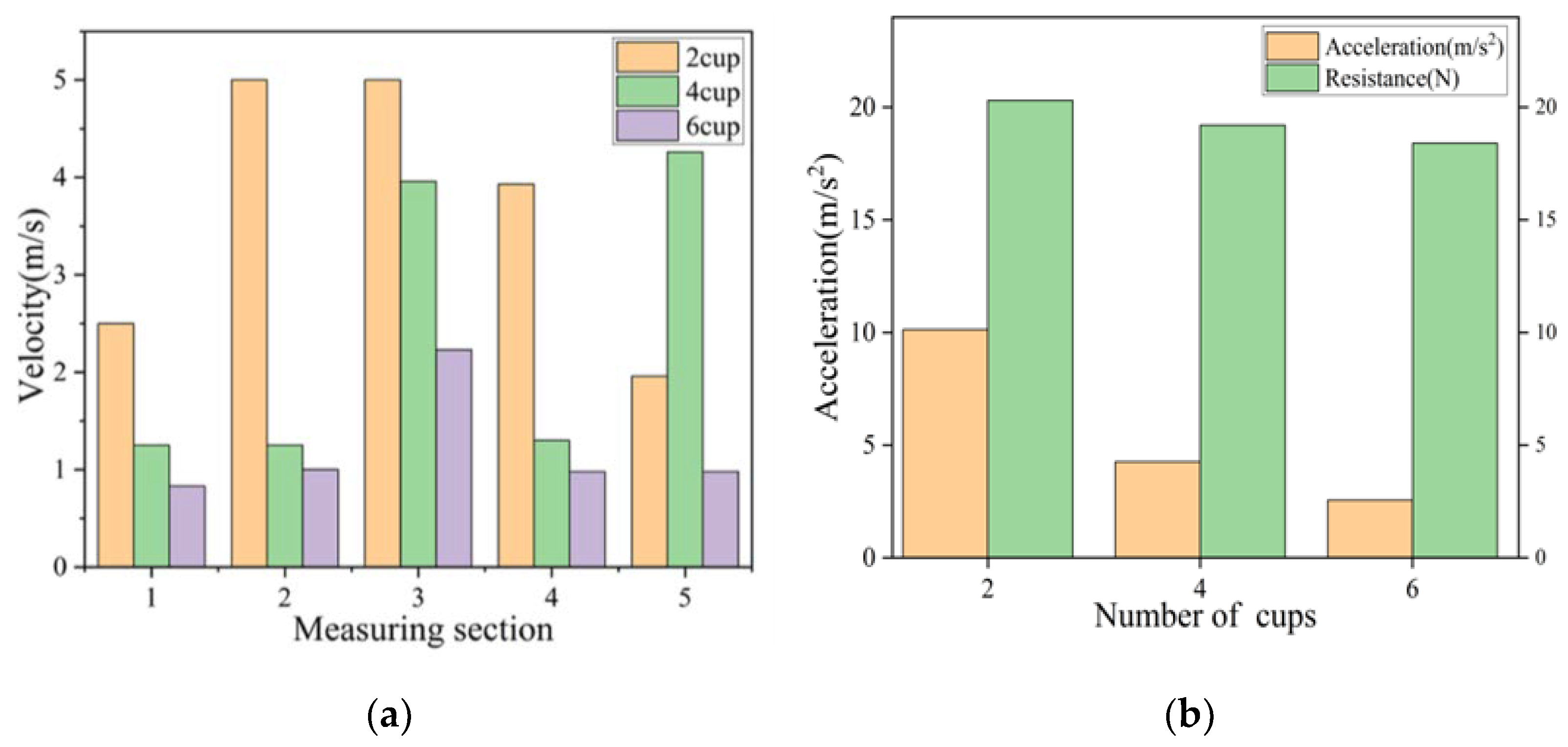




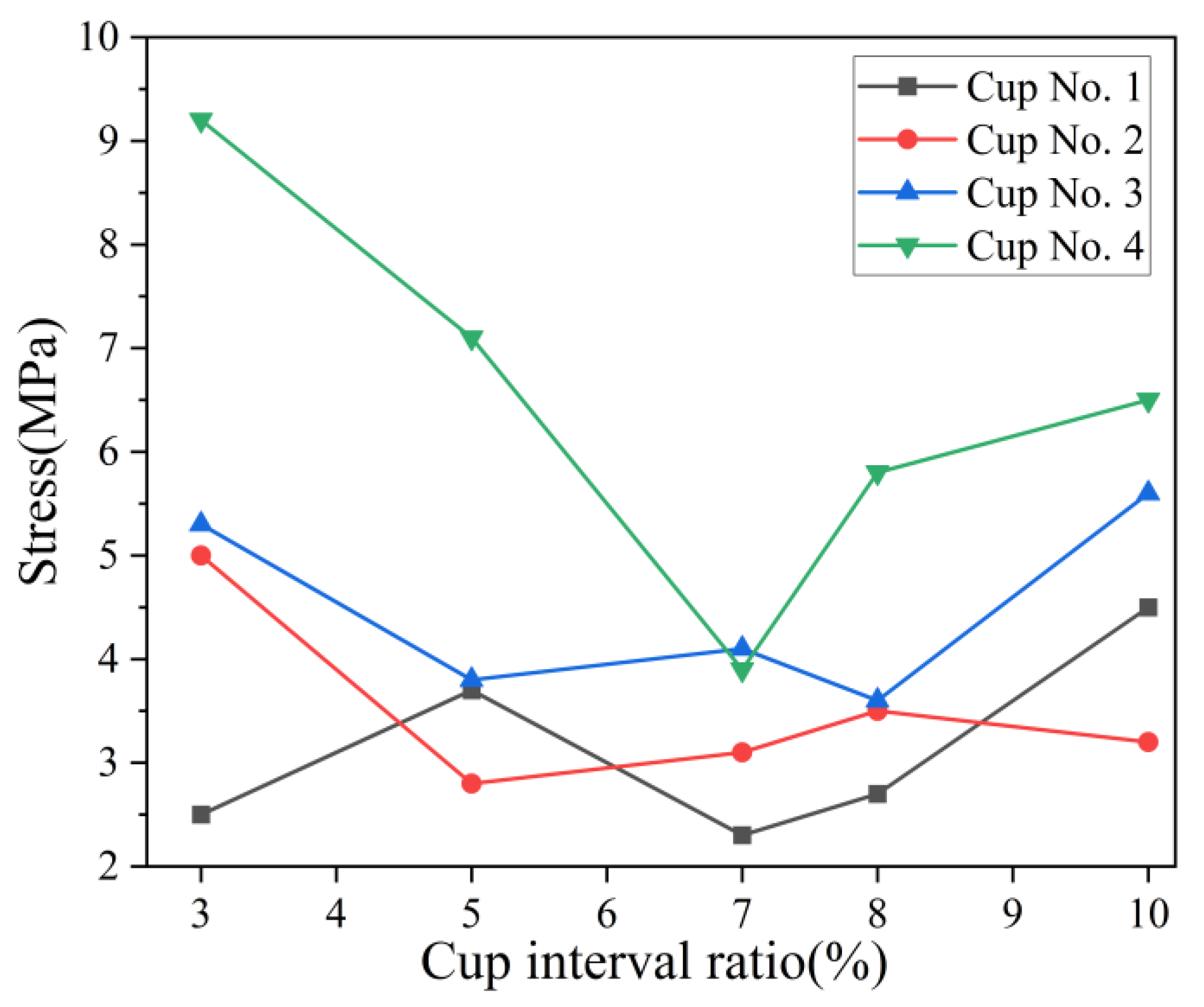

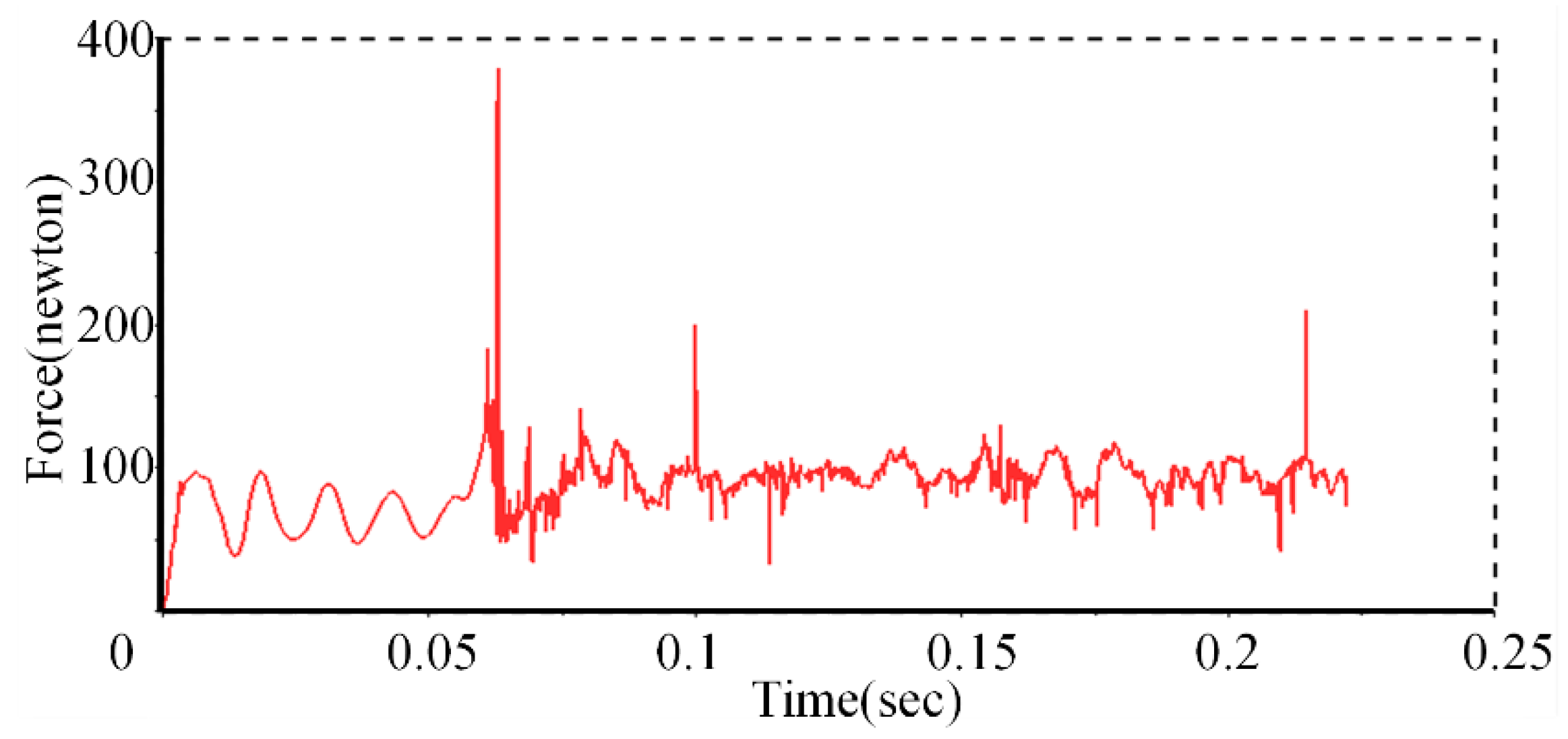


| Parts | Material/Model | Number |
|---|---|---|
| Straight pipes | Acrylic glass/stainless steel | 4 |
| Bends | Acrylic glass/stainless steel | 4 |
| Pipe fixing clips | Stainless steel | 8 |
| Pressure control pumps | CDMF10-8FSWSC | 1 |
| Pressure sensors | MIK-P300 | 13 |
| Flow meters | Caliber DN25 | 1 |
| Flow control valves | Caliber DN50 | 1 |
| Parts | Material | Dimensions (mm) |
|---|---|---|
| Flanges | Aluminum | 10 |
| Mandrel | Aluminum | 60 |
| Leather bowls | Polyurethane | 25 |
| End caps | Aluminum | 10 |
Publisher’s Note: MDPI stays neutral with regard to jurisdictional claims in published maps and institutional affiliations. |
© 2022 by the authors. Licensee MDPI, Basel, Switzerland. This article is an open access article distributed under the terms and conditions of the Creative Commons Attribution (CC BY) license (https://creativecommons.org/licenses/by/4.0/).
Share and Cite
Chen, S.; Xia, L.; Wang, X.; Teng, K.; Zhang, Y.; Zhang, M.; Gong, Y. Motion Law and Mechanical Properties of PIGs When Passing through a Pipe Bend. Machines 2022, 10, 963. https://doi.org/10.3390/machines10100963
Chen S, Xia L, Wang X, Teng K, Zhang Y, Zhang M, Gong Y. Motion Law and Mechanical Properties of PIGs When Passing through a Pipe Bend. Machines. 2022; 10(10):963. https://doi.org/10.3390/machines10100963
Chicago/Turabian StyleChen, Shengtao, Lei Xia, Xiaolu Wang, Kai Teng, Yibo Zhang, Meiyu Zhang, and Yongjun Gong. 2022. "Motion Law and Mechanical Properties of PIGs When Passing through a Pipe Bend" Machines 10, no. 10: 963. https://doi.org/10.3390/machines10100963
APA StyleChen, S., Xia, L., Wang, X., Teng, K., Zhang, Y., Zhang, M., & Gong, Y. (2022). Motion Law and Mechanical Properties of PIGs When Passing through a Pipe Bend. Machines, 10(10), 963. https://doi.org/10.3390/machines10100963





